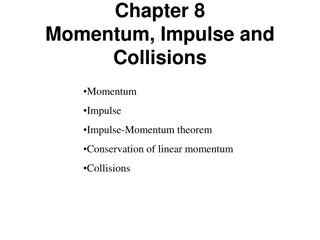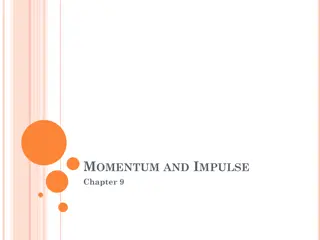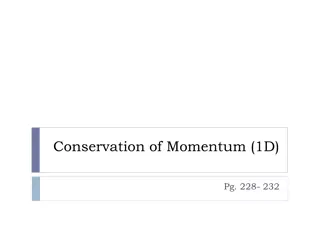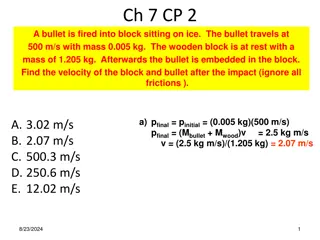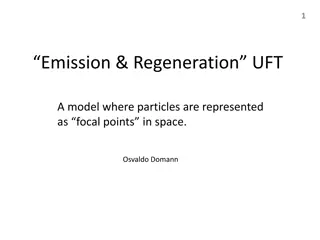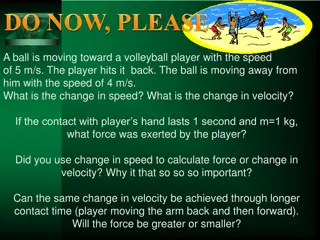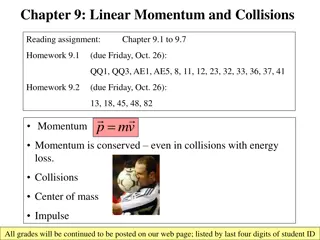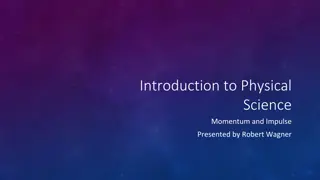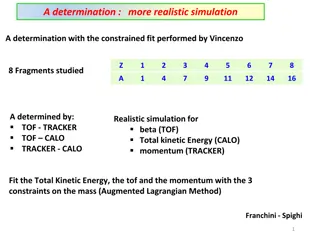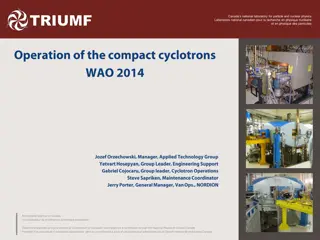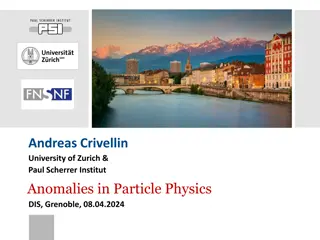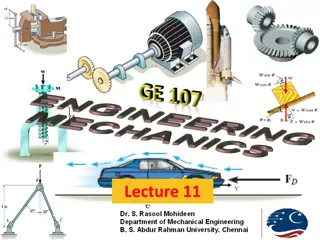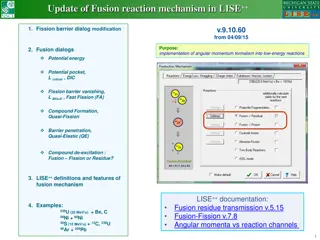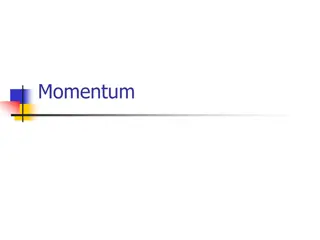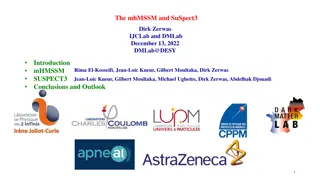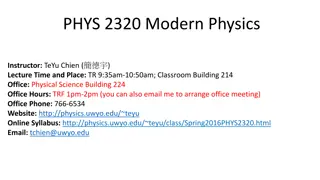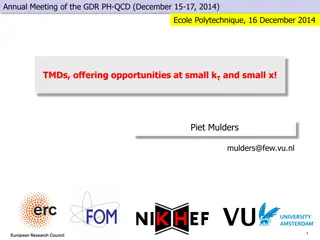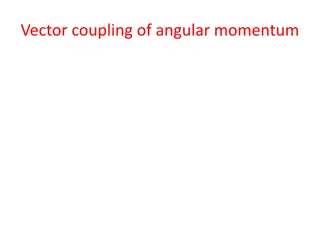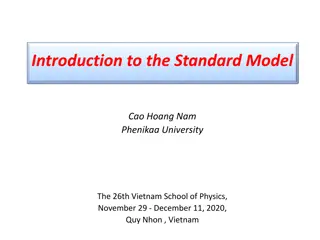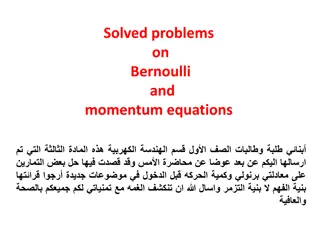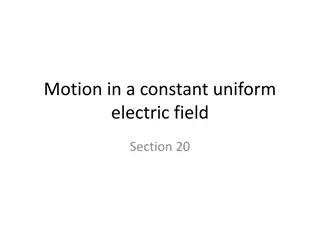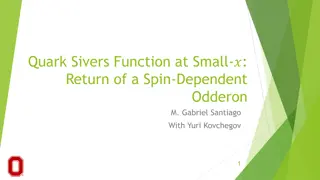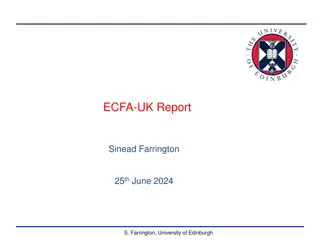Understanding Relativistic Energy and Momentum in Particle Physics
Discuss the new definition of momentum and the concept of total relativistic energy. Explore the use of momentum-energy conservation in scenarios involving zero rest mass particles. An example of an inelastic collision is provided to demonstrate the application of these principles.
Download Presentation

Please find below an Image/Link to download the presentation.
The content on the website is provided AS IS for your information and personal use only. It may not be sold, licensed, or shared on other websites without obtaining consent from the author. Download presentation by click this link. If you encounter any issues during the download, it is possible that the publisher has removed the file from their server.
E N D
Presentation Transcript
Recapitulate New definition of Momentum New concept of Total Relativistic Energy Use of Momentum Energy Conservation Zero rest mass particle, having finite energy and momentum but moving with speed c.
New Definitions = = p E mu mc dp dt 2 = F m u = m o 2 2 1 / c
Useful relationships 2 2 2 2 4 E = = = p c + m c 0 2 2 K mc m c o + 2 ( 1) m c u o 2 2 2 2 p c K 2 m c K o
Example 9: Inelastic Collision A particle of rest mass mo and kinetic energy 6moc2 strikes and sticks to an identical particle at rest. what is the rest mass and speed of the resultant particle?
Initial Energy = + + = 2 2 2 2 E m c 6 m c m c 8 m c o o o o Initial Momentum ( ) 2 = = 2 2 p 7 m c m c 48 m c o o o = + 2 2 2 2 4 E p c m c o
After the collision There exists a single particle with E=8moc2 and p= . We, therefore, get 48 o m c = = + 2 4 2 4 2 4 64 m c 48 4 m c m M c o o o M o o = + 2 2 2 2 4 E p c m c o
Find speed = = = = = 2 2 2 E M c 8 m c 2 M c u o o o 2 u p M u u o = 48 m c 8 m u o o 3 = u c 2
Alternately 1 = 2 2 u c 1 2 2 u c 1 4 = 1 2 3 = u c 2
Momentum Energy Transformation x p p p E c p p p x 0 1 0 0 0 0 i y y 0 0 i 0 0 = 1 0 z z E c i i vE c x y z = = = p p ; p p p ; p x y z 2 ( ) = E E vp x
Example 10: Decay into photons The speed of a particle of rest mass 135 MeV / c2 is found to be 0.8 c in a frame S . The frame S is observed to move with a speed of 0.6 c in another frame S. All the motions are collinear and are taken to be along x-axis. In S , it is found that the particle decays into two photons. Each of the photon makes an angle with the initial direction of the particle.
Find the angle and the frequency of the photon in this frame. Find the angle and frequency in S frame. E p1 S S y y E x O O E p2 x z z
In S Initial particle momentum and energy 1 5 3 = = u 1 (0.8) 2 5 3 = = = 2 E m c 135 225 MeV u o 5 3 135 c MeV c = = = p m u 0.8 c 180 u o 2
If Ep1and Ep2 are the energies of the two photons, p p + = E E E 225 E c E c MeV 1 2 p MeV c p 1 2 + = cos cos 180 c p p E 1 2 = sin sin c
This gives p p = = E E 112.5 MeV 1 2 180 225 o = cos = 36.87
In S: Method1(particle energy transformation) vE c = + p p 2 MeV c ( ) = + 0.6 225 1.25 180 MeV c = 393.75
( ) = + E E vp ( ) = = + 0.6 180 1.25 416.25 225 MeV MeV Now we can apply similar conservation laws in S and get the following results. 416.25 2 393.75 cos ; 416.25 = = = E E MeV 208.125 MeV p 1 p 2 = = o 18.92
Method2 (photon energy transformation) For Photon 1 in S frame. p = E 112.5 MeV 1
p E p x 1 = p cos 1 c 180 225 MeV c MeV c = = 112.5 90 p E p y 1 = p sin 1 c MeV c MeV c = = 112.5 0.6 67.5
Transformation to S frame p vE c p x 1 = + p p p x 1 1 2 MeV c ( ) = + 0.6 112.5 1.25 90 MeV c = 196.875
MeV c p y = = p p 67.5 p y 1 1 ( ) 1 = + E E vp 1 1.25 208.125 1 112.5 MeV x ( ) = = + 0.6 90 MeV 67.5 196.875 18.92 = tan = o
C-Frame and L-Frame Centre of Mass Frame (C-Frame) is defined as a frame in which the sum of momenta of all the particles are zero. In STR, problems can be simplified in C- Frame Many HEP experiments are planned in C- Frame so that energy is not consumed in accelerating c.m.
Example 11: Decay of a single particle A particle of rest mass Mo and total energy 3Moc2, decays into two identical particles of rest mass mo. Find the velocities of the two particles, given that the decay products move long the direction of motion of the parent particle.
In L Frame = = 2 E 3 3 M c o 2 1 = L 2 8 = 3 8 = = p 3 M c 8 M c L o o 3
L Frame Conservation Laws Conservation of Energy and Momentum 2 3 o M c M c In addition 2 1 2 2 L E = = + E E 1 L 2 L = + 8 p p o 1 L 2 L = + 2 2 2 4 E p c m c + L 1 L o 2 2 2 4 p c m c 2 L o It is not easy to solve these equations.
Go to C Frame As there only a single particle initially, we shall have following in C frame. = = 2 p 0; E M c x c o
Or transform to a frame, with 8 = = 3, v c 3 2 3 M c c 8 = = p 3 8 M c c 0 o x o 2 3 8 = = 2 2 E 3 3 M c c 8 M c M c c o o o 3
Conservation Laws in C Frame Conservation of energy and momentum = 2 2 M c 2 m c o C o M m = o C 2 o
The two particles will move in opposite direction with the following speed. 2 4 M m 1 = = v 1 c 1 c o 2 2 C o These speeds can now be transformed back to L frame.
Example12: Electron Collision An electron of total energy 1.4 MeV collides with another electron, which is at rest in the laboratory (L) frame. After collision the target electron scatters at an angle of 45o in the center of mass (C) frame.
Find the energy and the momentum components of the target electron after the scatter in the center of mass and laboratory frames. (Rest mass energy of electron 0.51 MeV)
Issues Energies known in L frame but angles given in C frame. Find Energy in C frame of the two particles. Let C frame travel in L frame with a speed v. Find momentum and Energy in C frame.
Energy and Momentum in L Frame Total initial energy of the two electrons = 1.4 .51 1.91 + = E MeV L The momentum of the first electron MeV c = = 2 2 p (1.4) (0.51) 1.304 L = + 2 2 2 2 4 E p c m c o
Method 1 MeV c v 1.4 c MeV 1 = p 1.304 x 2 v 0.51 c MeV 2 = p 0 x 2
For C frame 1 2 + = p p 0 x x This gives MeV c v v 1.4 c MeV 1.304 2 0.51 c MeV = + = 0 0 2 v .683 c Now evaluate and then Energy.
Method 2: The length of four vector ( ) 2 E c ( ) 2 Li p Li 2 = 2 2 (1.304) (1.91) 2 MeV c = 1.9482 MeV c = 1.396 i
In C Frame The length of four vector is same but the total momentum is zero. Hence we can evaluate the total energy.
( ) 2 E c Ci 2 MeV c = 1.396 i ( ) 2 2 E c MeV c Ci = 1.949 2
In C Frame The energy of the two electrons and the magnitude of the momenta are same. We therefore get the following. 1.396 2 = = E 0.698 MeV C MeV c = = 2 2 p (0.698) (0.51) 0.477 C
The magnitude of x and y component of the momenta are given by 0.477 MeV c = = = p p 0.337 Cx Cy 2
Relative speed of C frame in L frame 0.698 0.51 = = 1.369 2 1 1.873 1 1.873 = = = 2 0.466 2 = v 0.683 c
First Electron in L frame = + 0.683 0.698) p 1.369 (0.337 MeV c MeV 1 Lx = 1.114 = p 0.337 1 Ly c = + 0.683 0.337) E = 1.369 (0.698 MeV 1 1.27 L
Second Electron in L frame = + 0.683 0.698) p 1.369 ( 0.337 MeV c MeV = 2 Lx = 0.191 p 0.337 2 Ly c = 0.683 0.337) E = 1.369 (0.698 MeV 2 0.64 L
Check Conservation in L Frame After the collision the sum of energy and momenta components = + = E 1.27 0.64 1.91 MeV L MeV c = + 0.191 1.305 = p 1.114 Lx = = p 0.337 0.337 0 Ly This matches with the initial values within the truncation errors.
Energy considerations In which frame it takes lesser energy to perform such an experiment? In L-Frame the energy is 1.91 MeV In C-Frame the energy is 1.396 MeV
Example13: Minimum Energy for a process A proton (p) with kinetic energy K is incident on another proton at rest in L frame. After the interaction four particles are found, three proton and one anti proton. Find the least value of K needed for this process to happen.
C-Frame The least energy required would be when all the four particles are created at rest. But that is possible only when initial momentum is zero, which is in C- frame. The energy in C-frame is given by following.
= 2 E 4 m c C o The square of length of four vector in this frame is , therefore 2 2 16 m c o
Length of the four vector in L-Frame The square of length of four vector in L frame is given by the following E p c 2 2 2 ( ) 2 + 2 K 2 c m c 2 K c o = + 2 m K o 2 2 = 2 2 2 m K 4 m c o o
Equating the two = 2 2 2 2 16 = m c 2 m K 4 m c o m c o o 2 K 6 o This is the least K needed in L frame.


